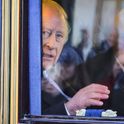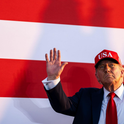Silvio Berlusconi was an Italian political and business revolutionary who was dedicated to preserving the status quo. In that regard, he was Trumpian well before Donald Trump. His media-driven techniques for gaining and holding onto power were revolutionary. But he used that power to try to prevent his country from modernising and reforming itself, and was largely successful in that effort. In some respects, he even took Italy backwards.
Berlusconi was undeniably Italy’s most successful prime minister in terms of years served and elections won, at least since the early 1990s, when the post-1945 party system dominated by the Christian Democratic Party (in power) and the Communist Party (always out of power, but formidably strong) crumbled in a massive corruption scandal. He occupied the elegant prime minister’s residence in Rome, Palazzo Chigi, three times (1994–95, 2001–06 and 2008–11), always at the head of coalition governments, until his coalition’s collapse forced him out of office in November 2011, to be replaced by the unelected technocrat Mario Monti.
Yet the strange point of Berlusconi’s nine years in office is that no major reforms or other legislation in that time can be attached to his name, beyond laws that protected him against prosecution by, for instance, reducing statutes of limitations and decriminalising activities of which he was accused (such as false accounting), and laws that preserved or extended his domination of broadcast communications.
Other than that, his main achievements were to prevent change: to keep out “communists”, as he termed all his opponents and critics (full disclosure: that accusation included this author and my then publication, the Economist, which he renamed The Ecommunist for criticising him on its cover in 2001 as “unfit to lead Italy”); and to thwart social or ethical change disliked by his supporters in the Roman Catholic Church, such as the legalisation of in vitro fertilisation or gay marriage. Despite often describing himself as a “liberal”, he was in truth a conservative.
That conservative label particularly came into its own in recent years, when his political power went into decline, eclipsed on the right wing of Italian politics by the more radical populist Matteo Salvini of the League (formerly Northern League) and the more traditionally rightist Giorgia Meloni of Brothers of Italy. Berlusconi repositioned himself as a moderating, centrist influence, leaning against anti-EU rabble-rousing by Salvini and establishing himself as a political kingmaker, which he duly became when Meloni won the general election in September 2022 and needed him as part of her coalition.
This was something of a comedown for a man who had been Italy’s dominant political figure from the moment he announced his entry into politics in 1993 until some hard-to-define moment in 2011–14, when the ebbing of his power became not just evident but likely to be permanent. Nevertheless, it kept him in the limelight, which has always been his most valued political location.
To a large degree, the rise both of Salvini and of the previously prominent centre-left figure who shares his first name, Matteo Renzi, reflected the revolution in political campaigning techniques that Berlusconi pioneered and perfected in the 1990s and 2000s. Berlusconi was revolutionary, by Italian standards, in his style of politics: it was not just that he was a wealthy businessman, but more that he made his own personality and his own life (both public and private) central to his campaign, and used modern media as the channel for it.
Not for him the backroom, shadowy world of the typical 1980s Italian Christian Democrat politician such as the seven-time prime minister Giulio Andreotti (“Il Divo” in Paolo Sorrentino’s celebrated 2008 film) or his own (ironically Socialist Party) patron, Bettino Craxi, who was discredited following the early 1990s corruption scandal and died in self-imposed exile. As befitted the owner since 1986 of one of Italy’s top football clubs, AC Milan, and no fewer than three national commercial TV stations, Berlusconi ran his campaigns by mixing the spirit of a football club with that of a reality TV series. The name of his first political party, formed in 1993 as his personal vehicle, was Forza Italia (“Go Italy”), which is a football chant.
Throughout his electoral campaigns, and indeed for much of the rest of the time, too, Berlusconi took every opportunity he could find to be the centre of attention. All publicity, in his book, was good publicity. No matter if this meant occasional gaffes, or contradicting himself on TV within days: the key point was the attention, so as to suck all the political oxygen away from opponents. Donald Trump may not in fact have been paying attention, but had he done so he would have learned a lot.
Where Berlusconi differed utterly from all previous (and indeed subsequent) Italian politicians was in his use of his private life—or at least a curated version of it—to create a rather special image of himself. Foreign media often portrayed Berlusconi’s dalliances with young women (which included being convicted, later cleared, of having sex with an underage prostitute), or all the talk of “bunga-bunga” sex parties, as being “scandals”, for that is what they would have been in any other country. For many Italians, however, they were an integral part of Berlusconi’s self-glamourising efforts.
This began, in the 1990s, in part simply as a display of the wealth and success of one of the country’s richest men, during his effort to build his support from what, when he entered politics, was a low base. It became, as the image grew more crafted, something of an appeal to an old version of masculinity—a vision of manhood taken from 1950s Italian cinema, the man always dominant, always surrounded by fawning beauties. No prowling paparazzi were required: Berlusconi arranged the cameras himself.
Towards the end, especially during his third spell as prime minister in 2008–11 and then afterwards, when he was still hoping to make a comeback, the image-making featured younger and younger women, a habit eventually denounced publicly by his then wife. It was as if a man, by then in his mid-70s, was trying to prove he had found the secret of eternal youth. All along, he banked on the idea—often correct—that more Italians would envy him than be outraged by him, even including a surprising number of older female voters.
This image-making, and his associated treatment of women, had at least the merit of consistency, unlike many of his political policies. It is precisely the technique he had used at his advertising agency and then in his commercial TV companies to build ratings: sex and showgirls, on as many posters and as many programmes as possible. Indeed, that use of sexualised female images stands as his main contribution to Italian culture, since even RAI, the public broadcaster, felt obliged to follow his lead.
Berlusconi’s business success began in property development in the late 1960s, chiefly with a big suburban development called Milano Two, that was financed by undisclosed sources—often speculated to have been Mafia money-laundering, but no proof has ever been found—and which enabled him to experiment with a local TV channel, Telemilano, the beginning of what would become a broadcasting empire. He then built the country’s largest advertising agency and, with help from a close relationship with Craxi when he was prime minister in 1983–87, secured the first nationwide commercial TV licences. His path to riches, and to a form of commercial and cultural dominance, was thus laid.
In 1994 he entered politics essentially to fill a vacuum left by the collapse of the previous political order. Given his associations with the discredited Craxi, and the accumulating accusations of financial illegality at some of his companies, he may also have done so in order to protect himself from prosecution. Indeed, he spent much of his next two decades in politics battling, and at times undermining, the judiciary, who he claimed were politicised (“communists”, all) and out to get him.
That said, once he was inside politics he accumulated and used power in very traditional Italian ways. His campaigning life was entirely transparent. His political life was behind closed doors. It is no coincidence that his name had, in 1981, been found in a list of members of “Propaganda Two”, a clandestine masonic lodge that connected together businessmen, politicians, journalists, spooks, soldiers and others. Such backroom connections and deployment of power through favours and hidden channels became his main modus operandi.
In that sense, Berlusconi stood for an old Italian idea of power and politics, even as he was portraying himself as a new broom, able to sweep away the old order. He could influence business through his dominance of advertising, whether placed by his agency or broadcast on his television channels. He could deploy ministerial roles to reward supporters, while wielding control over public funds. He formed coalitions that on the face of it made little sense—linking the supposed separatists of the then Northern League, who wanted independence from Rome, with the southern Italian Alleanza Nazionale, a party with fascist roots, along with his centre-right Forza Italia—but which cohered as ways to distribute resources and perks, rather than anything ideological.
This lack of ideology and lack, really, of any systematic national political organisation beyond a personal fan club is what characterised Berlusconi in office. His closest international relationships were with Vladimir Putin and Muammar Gaddafi, not for any philosophical reason but because they were men like him, leaders who ruled their countries as personal fiefs. He could cut deals with them as well as enjoying their company, in much the same way as Trump was liable to cosy up to strongmen leaders such as Putin and Kim Jong-un. (Allegedly, the phrase “bunga bunga” came to Berlusconi from Gadhafi.)
By contrast, he got on badly with conventional leaders of western democracies, such as Angela Merkel and Nicolas Sarkozy. He was for a time in favour with president George W Bush, because Italy joined the American-led military coalition in the Iraq War. For the same reason, and because he was an occasional ally in European Union councils, Tony Blair befriended him for a while.
Berlusconi’s downfall came in his third term in office, when he and his government simply had no answer to the eurozone financial crisis that hit in 2010. His government’s fiscal policy had been erratic, and as a result, yields on Italian government bonds soared once the crisis spread. Italy did not have a large budget deficit nor any property boom or bust, but its sovereign debt as a percentage of GDP was the eurozone’s second highest after Greece’s, a legacy of fiscal profligacy in the 1980s and the country’s own currency and debt crisis in 1992.
The Berlusconi administration’s economic record had been dismal. Italy’s GDP per head had barely grown (or even actively shrunk) during his 2001–06 and 2008–11 spells in government. The prime minister himself exuded denial: famously, he declared that all was well since restaurants in Italy were full. Unemployment, meanwhile, would go on to climb well above 10 per cent of the workforce. Young Italians, stuck on lowly paid and insecure short-term contracts, began to leave the country, especially if they had good degrees and professional qualifications. A century earlier, Italian emigration to the United States and to South America had been made up mainly of the poor and uneducated. Now, it was the wealthier and well-qualified.
As the financial crisis grew, so discontent with Berlusconi grew within his own coalition. A defeat in parliament, and signs of a split in his Forza Italia party, gave Italy’s then president Giorgio Napolitano an excuse to force him out and replace him with Mario Monti, at the head of a coalition which included many of Berlusconi’s own supporters.
He was out of office, and humiliated, but it was too soon to count him out. Even a tax fraud conviction in 2012, for which he eventually served one year of community service but under which he was also banned from holding political office for five years (later reduced to two) did not dent his political aura. Since he had long wielded his real power behind the scenes, and since he remained a billionaire, he was fully expected to remain a central political figure. Few dared to bet against the possibility even of an eventual return to Palazzo Chigi. In 2019, with the ban on political office removed, Berlusconi got himself elected to the European Parliament.
As he now finally leaves the stage—or il campo, or football field, as he preferred—he does so in that new guise of a moderate conservative, a statesmanlike restraint on Italy’s new extremists on the right. That guise is as fake as his hair transplants. The anti-LGBTQ, anti-abortion and anti-immigrant stances taken by Giorgia Meloni’s government in its first months in office have been directly in line with those of Berlusconi’s own governments.
He made the right electable, made respectable the descendants of fascism that make up Meloni’s party, and, by refusing ever to retire, made it impossible for a more moderate and centrist leadership to emerge. That is his legacy.












